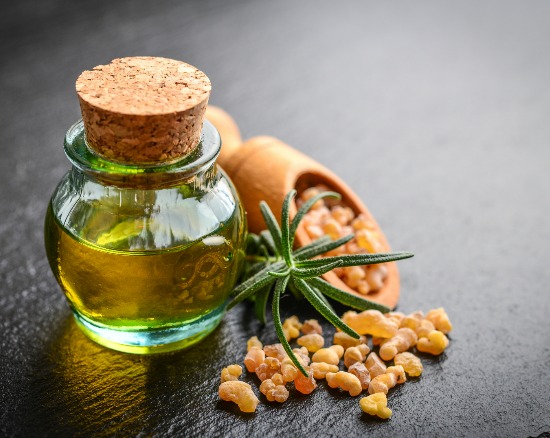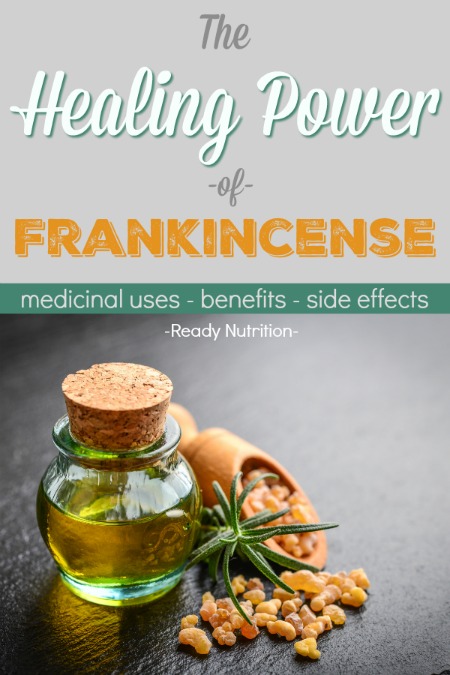
In the Bible, frankincense is one of three gifts that the wise men offered to the infant Jesus, possibly because of its healing powers.
What IS frankincense?
Frankincense – also called olibanum – is made by extracting the milky white sap of the tree’s bark and then hardening it into a resin. The resin is made into an oil via steam distillation. Then, the oil is either used on the skin or by inhalation.
Frankincense oil is sourced from Boswellia carterii, Boswellia ferreana or Boswellia serrata trees that grow in African and Arabian regions, including Yemen, Oman, Somalia, and Ethiopia.
There are many types of frankincense, and its quality is based on color, purity, aroma, age, and shape. The trees can produce different colored resins. Silver and Hojari are generally considered the highest grades of frankincense. Brown-yellow and muddy frankincense are typically the cheapest and easiest to find.
Benefits
Substances found in frankincense have a number of possible health benefits.
These substances include terpenes and boswellic acids, which have strong anti-inflammatory properties and protect healthy cells. Boswellic acid inhibits 5-lipoxygenase, and it might also target free radicals and cytokines, according to the authors of a study published in Planta Medica. All of these play a role in inflammation.
Frankincense also can…
- Help control bleeding and speed up the wound-healing process
- Fight inflammatory conditions such as arthritis, and improve uterine health
- Be used to help alleviate stress and relieve pain
- Kill germs – it has antiseptic and antimicrobial properties. It works especially well when combined with myrrh
- Help keep your mouth clean and healthy – there are natural kinds of toothpaste made with frankincense because of its antiseptic properties
- Treat dry skin and reduce the appearance of wrinkles, age spots, scars, and stretch marks
- Relieve colic and intestinal gas (flatulence)
- Provide relief for respiratory irritation due to colds, the flu, asthma, and bronchitis
In aromatherapy, frankincense oil is typically used for the following conditions:
- Acne
- Anxiety
- Colds
- Coughs
- Indigestion
- Ulcers
As you can see, frankincense oil has much to offer therapeutically.
But perhaps most impressive, frankincense may actually help fight cancer.
Cancer
Frankincense appears to attack cancer cells directly. Some researchers believe it could benefit people with certain types of cancer, including that of the pancreas, breast, and bladder.
Current research is limited, but so far, findings are promising.
It is known that chronic inflammation can damage DNA and lead to cancer. It is possible that frankincense helps fight cancer via its anti-inflammatory properties,
But, some research suggests it may directly attack cancer cells. In one study, researchers found that the oil appears to distinguish cancerous from normal bladder cells and suppress cancer cell viability. In other words, it is possible that frankincense oil might target cancer cells without harming healthy cells (unlike chemotherapy and other conventional cancer treatments, which kill both).
At least two other studies have produced similar findings, according to a recent report from Medical News Today:
In 2015, further lab research found similar effects in breast cancer. The investigators found that frankincense could kill breast cancer cells and disrupt the growth of future cancer cells.
In 2016, scientists describing the properties of frankincense noted that it contains substances that have anti-tumor properties. These could prevent cancer cells from growing and lead to controlled cell death, or apoptosis.
The findings of two older studies also suggest that frankincense may help fight cancer.
In 2013, researchers in China studied the effects of frankincense and myrrh on five tumor cell lines in a lab. They found that human breast and skin cancer cells showed increased sensitivity to the combination of oils.
A 2012 study found that a chemical compound in frankincense called AKBA is successful at killing cancer cells that have become resistant to chemotherapy.
More research needs to be conducted, including human trials, but frankincense may be used as a safe cancer treatment in the future.
How to use frankincense
Frankincense essential oil is used by either inhaling the oil or by applying it topically.
Be sure to purchase the essential oil and not “fragrance oil”, which usually does not offer the same health benefits. With essential oils, a little goes a long way; usually, one to three drops is all that is needed.
Before applying the oil to the skin, be sure to blend it with a carrier oil like coconut oil, grape seed oil, olive oil, hemp seed, jojoba, avocado oil, or sweet almond oil. Used this way, frankincense may help alleviate joint or muscle pain, promote hair root health and stimulate healing of cuts, acne, insect bites, or boils. You also can combine the oil with a little lotion, or apply a few drops to a compress. Again, remember – a little goes a long way. When essential oils are applied topically, they are absorbed by your skin, and it is possible to overdo it. Always do a patch test when using a new essential oil (dilute it with your carrier first!) to make sure you don’t experience irritation, an allergy, or a burn.
To inhale the oil, you can use an aromatherapy essential oil diffuser. You can make your own by using a small container, the carrier oil of your choice, the essential oil, and a little vodka. For instructions (and additional oil combinations to try) please see DIY: How To Naturally Make An Essential Oil Diffuser {Plus Aromatherapy Oil Blends}. This type of therapy interacts with the “emotional brain” or limbic system. During inhalation, odor molecules travel through the nose and affect the brain through a variety of receptor sites, one of which is the limbic system.
You can add a few drops of frankincense oil to a vaporizer, or add it to your bath (try combining it with a little whole milk first so the oil mixes with your bath water).
Special precautions and possible side effects
Frankincense is generally believed to be safe, but there are some possible concerns and guidelines to understand.
First, be sure to purchase therapeutic-grade oil.
Store essential oils out of reach of children and pets.
Do not ingest the essential oil, as it may have toxic effects (and can even be fatal) when taken internally.
Avoid getting essential oils in your eyes, nose, or ears. Wash your hands thoroughly after working with the oils. Wearing gloves while working with pure essential oils is a good idea, especially if you are making various products with them. Be sure to work in a well-ventilated area.
Be sure to dilute the oil with a carrier oil or lotion prior to topical use. Because essential oils are concentrated, using them without diluting them may cause skin irritation.
If you are pregnant or nursing, avoid using frankincense oil because it may trigger contractions, prompt menstruation, and lead to a miscarriage.
Frankincense is not known to interact with any medications, but that doesn’t mean there isn’t a risk. If you are concerned about interactions or have special health concerns, you may want to see your healthcare provider prior to use.

This article was originally published at Ready Nutrition™ on December 3rd, 2018






